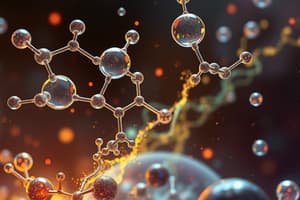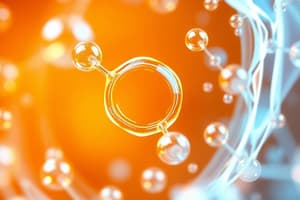Podcast
Questions and Answers
What are the general physical properties of amines?
What are the general physical properties of amines?
- Polar characteristics, solubility in water, and basic behavior towards acidic protons. (correct)
- Polar characteristics, insolubility in water, and basic behavior towards basic protons.
- Nonpolar characteristics, high solubility in water, and acidic behavior towards acidic protons.
- Nonpolar characteristics, insolubility in water, and acidic behavior towards basic protons.
What is a significant characteristic of amines in terms of chemical reactions?
What is a significant characteristic of amines in terms of chemical reactions?
- They are resistant to nucleophilic substitution reactions.
- They are not involved in hydrogen bonding.
- They undergo nucleophilic addition reactions with carbonyl compounds. (correct)
- They do not interact with electrophilic carbon centers.
What role do primary and secondary amines play in drug development?
What role do primary and secondary amines play in drug development?
- They serve as biologically active moieties. (correct)
- They are not used in drug development.
- They are only used as intermediates in drug synthesis.
- They act as catalysts for drug synthesis.
How do amines tend to influence catalysis processes?
How do amines tend to influence catalysis processes?
Which characteristic of amines makes them suitable for applications in surfactants and polymers?
Which characteristic of amines makes them suitable for applications in surfactants and polymers?
What type of chemical reaction are amines particularly susceptible to?
What type of chemical reaction are amines particularly susceptible to?
What distinguishes aliphatic amines from aromatic amines?
What distinguishes aliphatic amines from aromatic amines?
How do primary amines primarily form?
How do primary amines primarily form?
Which type of amine results from nucleophilic substitution reactions?
Which type of amine results from nucleophilic substitution reactions?
What leads to the formation of quaternary ammonium salts?
What leads to the formation of quaternary ammonium salts?
What is the unique property of secondary amines?
What is the unique property of secondary amines?
Why are amines considered pivotal across various industries?
Why are amines considered pivotal across various industries?
Study Notes
Amine Chemistry
Amines, belonging to the family of organic compounds featuring nitrogen atoms bonded with hydrogen and carbon, play a pivotal role across various industries due to their versatile chemistry and unique properties. In this exploration, we will delve into the classification, preparation methods, physical attributes, chemical interactions, importance, and uses of these fascinating molecules called amines.
Classification of Amines
Amines can be classified according to the number of alkyl or aryl groups attached to the nitrogen atom. Aliphatic amines have one or more alkyl substituents while aromatic amines contain phenyl or other aromatic rings connected to the nitrogen atom. Common categories of amines include primary amines (NH_2), secondary amines (-NR_-R'), and tertiary amines (-NR_2-R'). Moreover, there exist special cases such as quaternary ammonium salts which possess four different substitutions around the N atom.
Preparation of Amines
Primary amines can form through several routes including reduction of nitroalkanes, hydrolysis of imides, reaction between ammonia and electrophiles, and decarboxylation of amino acids. Secondary and tertiary amines originate from nucleophilic substitution reactions where halogenated derivatives react with amide bases like ammonia or primary amines. Quaternary ammonium salts arise when a tertiary amine reacts with strong acids to replace one H atom by negative ions like chloride or bromide. Synthetic chemists often utilize these strategies to obtain desired amines as building blocks for further transformation.
Physical Properties of Amines
Generally speaking, amines exhibit polar characteristics, solubility in water, and basic behavior towards acidic protons (e.g., -OH or -COOH) due to lone pairs present on nitrogen atoms. They also display diverse boiling points depending upon the nature and size of R groups, ranging from low for small alkyl chains to high for large or bulky groups. As a result of their ability to donate electron pairs, amines tend to engage in hydrogen bonding with neighboring molecules.
Chemical Reactions of Amines
One significant characteristic of amines is their susceptibility to undergo nucleophilic substitution reactions, particularly those involving electrophilic carbon centers. For instance, they may displace halogens from haloalkanes, sulfur from thiocyanates, mercury(II) from organomercurials, or positively charged species from metal complexes. Furthermore, amines interact readily with carbonyl compounds via nucleophilic addition leading to Schiff base formation or Michael addition, thereby influencing catalysis processes, polymerization, and natural product synthesis.
Importance and Uses of Amines
Due to their multifaceted capabilities, amines find numerous applications spanning pharmaceuticals, agrochemicals, textile processing agents, surfactants, polymers, dyes, rubber additives, recyclable plastics, and corrosion inhibitors. Primary and secondary amines serve extensively in drug development as biologically active moieties, while tertiary amines act as catalysts and intermediates in many industrial processes. Beyond traditional roles, amines hold potential as renewable energy sources, energy storage materials, and precursors for conducting polymers.
Studying That Suits You
Use AI to generate personalized quizzes and flashcards to suit your learning preferences.
Description
Explore the world of amines - organic compounds containing nitrogen atoms bonded with hydrogen and carbon - by learning about their classification, preparation methods, physical attributes, chemical interactions, importance in various industries, and diverse applications. Discover the significance of amines in pharmaceuticals, agrochemicals, polymers, and more.




